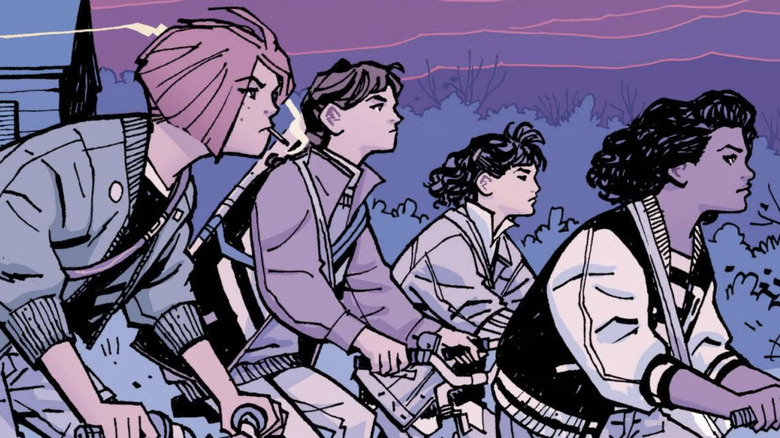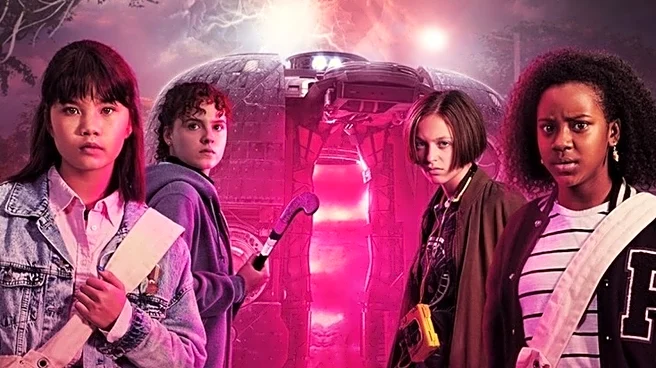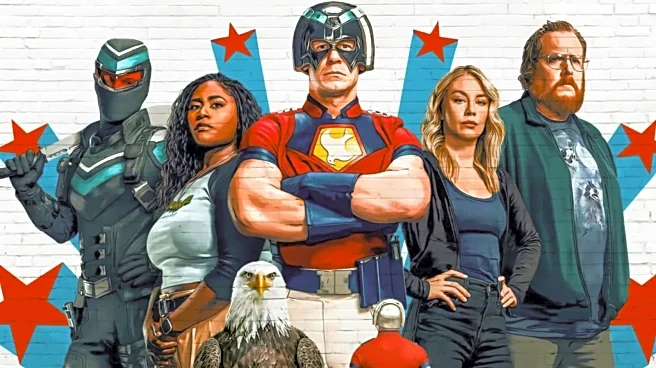
"Stranger Things" will finally be releasing its fifth and final season at the end of 2025. It's debatable whether it's one of the best TV shows of the last decade, but it's absolutely one of the most important. It's a premier series for both the Netflix boom and interminable '80s nostalgia. (At least "Stranger Things" got Gen Z to love Kate Bush.
)Naturally, other streaming services have tried to copy the success of "Stranger Things" — one of those attempts was the short-lived "Paper Girls" on Prime
Video. Now, granted, "Paper Girls" is based on a comic by writer Brian K. Vaughan and artist Cliff Chiang. That comic actually predates "Stranger Things." "Paper Girls" ran for 30 issues, collected in six volumes, between 2015 and 2019.
Still, the central image of kids on bikes riding through Midwest suburbia invites comparisons to "Stranger Things," and gives away the audience the show was chasing. The big difference is that while "Stranger Things" depicts a parallel dimension seeping into reality, "Paper Girls" is about time travel.
The series follows four middle school girls who are all, well, paper delivery girls in Stony Stream, Ohio, a fictional Cleveland suburb. Our paper girls are "new girl" Erin Tieng (Riley Lai Nelet), straight-A video game geek Tiffany Quilkin (Camryn Jones), chain-smoking bad girl Mackenzie "Mac" Doyle (Sofia Rosinsky), and rich girl Karina "KJ" Brandman (Fina Strazza). The girls come together on their paper route during the early hours of November 1, 1988. That day, they discover a time machine and find themselves caught in a conflict between different time travelers. As they go through the decades, they face their own futures for good and ill.
The audience, though, has been cut off from the paper girls' futures because the series didn't get enough viewership to continue for more seasons.
Read more: 15 Best Netflix Limited Series, Ranked
Sadly, Paper Girls Lived And Died In The Rings Of Powers' Shadow

Adapted for TV by Stephany Folsom (a screenwriter of "Toy Story 4"), all eight "Paper Girls" episodes premiered on Prime Video on July 29, 2022. But it didn't pick up enough interest, nor did Amazon give it much of a chance too, and was canceled two months later. Reporting suggested that the show was buried by Prime Video's "The Lord of the Rings: The Rings of Power" (which premiered in September 2022) and that series' massive marketing campaign. (Ironically, Folsom herself was a writer on "Rings of Power" season 1.)
It was reported that "Paper Girls" production company Legendary Television would try and find the home at a different streaming service, but there were no takers. The show's cast had also indicated they were excited to see the story and their character through in future seasons, but they didn't get the chance.
We at /Film loved "Paper Girls," and if you did too, don't worry. You're not out of options because the comic told a full story. If the "Paper Girls" series ever returns, or the story gets adapted again, it'll be because of how beloved the comic is.
You see, "Stranger Things" is not the only TV trend that "Paper Girls" lies inside. The same era (late '90s to early 2010s) that brought us prestige TV also brought us prestige comics, i.e. creator-owned, long-running series, predominantly published at either DC's imprint Vertigo or Image Comics, that attracted mainstream literary acclaim few comics previously had. Almost all of these have become TV series now, from "The Walking Dead," to "Preacher," but few have reached the enduring popularity of the original comics.
Vaughan is one of the writers most associated with this trend, from his breakout Vertigo series "Y: The Last Man" to his still running space opera "Saga" to "Paper Girls." The work of his closest to "Paper Girls," though, is his Marvel series, "Runaways," about six California teens who discover their parents are a cabal of super-villains. Both series are high concept stories of generational conflict, with a group of teens on the run and suffering the consequences of adults' meddling.
The Paper Girls Comic Resolves What The Show Couldn't

Spoilers for "Paper Girls" follow.
Whereas the Runaways became just another piece of the Marvel universe, "Paper Girls" concluded on its own terms with a defining message. Here's a hint about the comic's feelings on nostalgia: one of the comic's late act twists is that time travel can give you cancer — reliving the past is literally lethal.
If you loved the "Paper Girls" show, you owe yourself to read the comic. It doesn't line up one-to-one, granted. The unresolved cliffhanger of season 1 features Erin and Tiffany landing in what appears to be the 1970s, which was not a major setting in the comic. (There, the girls bounce from the 2010s to prehistoric times to Y2K to the 22nd century.) But the paper girls are no less vibrant or alive in Chiang's drawings than they were when played onscreen, and I'm sure the show's ending would've been the same in broad strokes.
During "Paper Girls," the four leads learn through their travels, and meeting their alternate selves, that if not for finding the time machine, they would've hung out for a few weeks and gone their separate ways. If their memories are erased, that's exactly what'll happen again. "Paper Girls" issue #30 comes full circle, showing how that November 1 morning would've played out for the paper girls without any time traveler interference. Except, when the girls (who don't remember their time traveling) all go to ride off on their own bike paths, Erin calls out and says they should stay together. The last page of the comic is a full page panel of them riding off into the sunrise.
"Paper Girls" has hammered in from the beginning that fate is irreversible, so it ends on a note of hope that maybe the girls will defy the odds and stay friends. "Paper Girls" season 2 remains unlikely, but the comic also teaches that you should cherish the time you're given, not try and find more of it.
If you're looking for the easiest way to keep up with all the major movie and TV news, why not sign up to our free newsletter?
Read the original article on SlashFilm.













